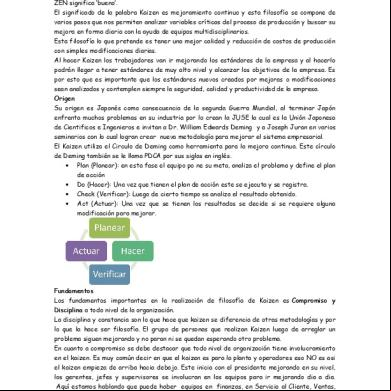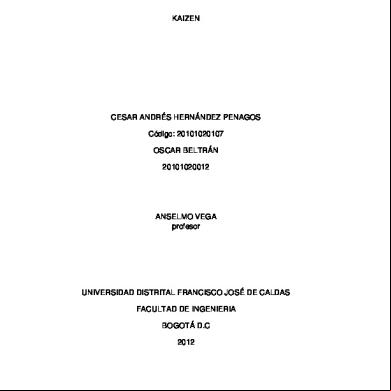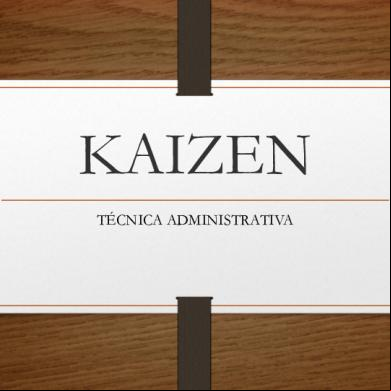Kaizen 3n136o
This document was ed by and they confirmed that they have the permission to share it. If you are author or own the copyright of this book, please report to us by using this report form. Report 2z6p3t
Overview 5o1f4z
& View Kaizen as PDF for free.
More details 6z3438
- Words: 942
- Pages: 35
Introduction to Kaizen Kaizen & Management
SDCA/PDCA Cycle Kaizen vs Innovation Kaizen Philosophy Methods to Increase productivity
Cost reduction Principle Three MU’s: Muda, Mura, Muri Seven types of Waste Modern Perception of Kaizen & Job Functions
Stages of the Kaizen The 5W & 1H of Kaizen
The Japenese word “Kaizen” (改善) means chane (KAI) to become good (ZEN)
Kaizen means improvement. Improvements without spending much money,
involving everyone from managers to employees, and using much common sense.
The aspect of Kaizen is that it is on-going and never-ending improvement process.
“Continuous effort - not strength or intelligence - is the key to unlocking our potential.“ Sir Winston Churchill
SDCA • Do first • Maintain • Standardize & Stabilize current Process
PDCA • Do Next • Improve • Further Improve • Standardized & Stabilized Process
Kaizen
Innovation
Un-dramatic Low Cost Low Risk Human Effort No Brainer
Dramatic High Cost High Risk Technology More Thought
Expose Problems
Current State Full of Waste, Variation and Constraints
Future State Solve Problems
True North Value added time= Lead Time
Implement good housekeeping and workplace organization. Identify and eliminate all activities that are waste. Implement standardization
More Workers
Quantitative Approach
How to Increase Productivity?
More Machines
Work Longer
Qualitative Approach
Work Harder Eliminate Waste & Simplify
Higher profit is achieved by increasing sales price
Profi t1 Sale s Pric e1
Cost 1
Higher profit is achieved by reducing cost(waste) while maintaining sales price
Profi t2
Cost 2
Sale s Pric e2
Cost Plus Principle
Profi t1 Sale s Pric e1
Profi t2
Cost 1 Cost 2
Sale s Pric e2
Cost Reduction Principle
Top Management Middle Management
Supervisors Management
Workers
Innovation
Kaizen
The Standard Work elements of a Kaizen are:
Start
Document Reality
• Document the Current Process • We need to understand how processes are performed today (may be done prior to Kaizen as well)
Take the time to validate the baseline information and understand what is happening in the area.
Document Reality
The Standard Work elements of a Kaizen are:
Start Identify Waste
Document Reality
• Those elements that do not increase the value of a product or service, but only increase cost
Identify Waste
The Standard Work elements of a Kaizen are:
Start Identify Waste
Plan Countermeasures
Document Reality
•Focus on the things that can be done within the kaizen •Low cost solutions, creativity before money •Right-sized resources •Maximum waste elimination
Plan Countermeasures
The Standard Work elements of a Kaizen are:
Start
Document Reality
Identify Waste
Plan Countermeasures
Reality Check
Problem/Countermeasure Tracking • The Facilitator and Team Leaders review the countermeasures and the to-do list to ensure: o Proper Direction o Countermeasures are the proper Lean solutions • If necessary, course corrections are made • The Lean Facilitator approves the plan
Reality Check
The Standard Work elements of a Kaizen are:
Start
Document Reality
Identify Waste
Plan Countermeasures
Reality Check
Make Changes
• Implement the planned changes • Use the Kaizen Implementation Report to document the change
• Do not dictate how things will be done. Ask team , build coalition(alliance for combined action) • Hold progress meetings each day
Make Changes
The Standard Work elements of a Kaizen are:
Start
Document Reality
Identify Waste
Plan Countermeasures
Reality Check
Make Changes
Change
• Observe again
• Results Achieved? • If not, go back and make additional changes
• Repeat the cycle – observe, implement changes, evaluate
Change
The Standard Work elements of a Kaizen are:
Start
Document Reality
Identify Waste
Measure Results Plan Countermeasures
Reality Check
Make Changes
Change
•Did waste get eliminated? •Can improvements be sustained?
•Are improvements aligned with business objectives? •Is there a possibility of negative unintended consequences? •Were kaizen and individual improvement objectives achieved?
Measure Results
Start
Document Reality Make this the Standard
Identify Waste
Measure Results Plan Countermeasures
Reality Check
Make Changes
Change
• Establish visual controls (boards, taping, signs, etc.) to ensure progress is maintained. • Results must be repeatable and sustainable.
Make this the standard
The Standard Work elements of a Kaizen are:
Start
Do It Again
Document Reality
Celebrate Make this the Standard
Identify Waste
Results A new way of work Plan Countermeasures
Reality Check
Make Changes
Measure Results
Change
An office desk before and after conducting kaizen and set in order. Clutter and unused items have been removed leaving only what is needed
Organized tools and materials for better shopfloor productivity and safety
Who?
What?
Where?
1. 2. 3. 4. 5. 6.
1. 2. 3. 4. 5. 6.
1. 2. 3. 4. 5.
Who does it? Who is doing it? Who should be doing it? Who else can do it? Who else should do it Who is doing 3-Mu’s?
What to do? What is being done? What should be done? What else can be done? What else should be done? What 3-Mu’s are being done?
Where to do it? Where is it done? Where should it be done? Where else can it be done? Where else should it be done? 6. Where are 3-Mus’s being done?
When?
Why?
How?
1. 2. 3. 4.
1. 2. 3. 4.
1. 2. 3. 4.
When to do it? When is it done? When should it be done? What other time can it be done? 5. What other time should it be done?
Why does he do it? Why do it? Why do it there? Why do it that way?
How to do it? How is it done? How should it be done? Can this method be used in other areas? 5. Is there any other way to do it?
SDCA/PDCA Cycle Kaizen vs Innovation Kaizen Philosophy Methods to Increase productivity
Cost reduction Principle Three MU’s: Muda, Mura, Muri Seven types of Waste Modern Perception of Kaizen & Job Functions
Stages of the Kaizen The 5W & 1H of Kaizen
The Japenese word “Kaizen” (改善) means chane (KAI) to become good (ZEN)
Kaizen means improvement. Improvements without spending much money,
involving everyone from managers to employees, and using much common sense.
The aspect of Kaizen is that it is on-going and never-ending improvement process.
“Continuous effort - not strength or intelligence - is the key to unlocking our potential.“ Sir Winston Churchill
SDCA • Do first • Maintain • Standardize & Stabilize current Process
PDCA • Do Next • Improve • Further Improve • Standardized & Stabilized Process
Kaizen
Innovation
Un-dramatic Low Cost Low Risk Human Effort No Brainer
Dramatic High Cost High Risk Technology More Thought
Expose Problems
Current State Full of Waste, Variation and Constraints
Future State Solve Problems
True North Value added time= Lead Time
Implement good housekeeping and workplace organization. Identify and eliminate all activities that are waste. Implement standardization
More Workers
Quantitative Approach
How to Increase Productivity?
More Machines
Work Longer
Qualitative Approach
Work Harder Eliminate Waste & Simplify
Higher profit is achieved by increasing sales price
Profi t1 Sale s Pric e1
Cost 1
Higher profit is achieved by reducing cost(waste) while maintaining sales price
Profi t2
Cost 2
Sale s Pric e2
Cost Plus Principle
Profi t1 Sale s Pric e1
Profi t2
Cost 1 Cost 2
Sale s Pric e2
Cost Reduction Principle
Top Management Middle Management
Supervisors Management
Workers
Innovation
Kaizen
The Standard Work elements of a Kaizen are:
Start
Document Reality
• Document the Current Process • We need to understand how processes are performed today (may be done prior to Kaizen as well)
Take the time to validate the baseline information and understand what is happening in the area.
Document Reality
The Standard Work elements of a Kaizen are:
Start Identify Waste
Document Reality
• Those elements that do not increase the value of a product or service, but only increase cost
Identify Waste
The Standard Work elements of a Kaizen are:
Start Identify Waste
Plan Countermeasures
Document Reality
•Focus on the things that can be done within the kaizen •Low cost solutions, creativity before money •Right-sized resources •Maximum waste elimination
Plan Countermeasures
The Standard Work elements of a Kaizen are:
Start
Document Reality
Identify Waste
Plan Countermeasures
Reality Check
Problem/Countermeasure Tracking • The Facilitator and Team Leaders review the countermeasures and the to-do list to ensure: o Proper Direction o Countermeasures are the proper Lean solutions • If necessary, course corrections are made • The Lean Facilitator approves the plan
Reality Check
The Standard Work elements of a Kaizen are:
Start
Document Reality
Identify Waste
Plan Countermeasures
Reality Check
Make Changes
• Implement the planned changes • Use the Kaizen Implementation Report to document the change
• Do not dictate how things will be done. Ask team , build coalition(alliance for combined action) • Hold progress meetings each day
Make Changes
The Standard Work elements of a Kaizen are:
Start
Document Reality
Identify Waste
Plan Countermeasures
Reality Check
Make Changes
Change
• Observe again
• Results Achieved? • If not, go back and make additional changes
• Repeat the cycle – observe, implement changes, evaluate
Change
The Standard Work elements of a Kaizen are:
Start
Document Reality
Identify Waste
Measure Results Plan Countermeasures
Reality Check
Make Changes
Change
•Did waste get eliminated? •Can improvements be sustained?
•Are improvements aligned with business objectives? •Is there a possibility of negative unintended consequences? •Were kaizen and individual improvement objectives achieved?
Measure Results
Start
Document Reality Make this the Standard
Identify Waste
Measure Results Plan Countermeasures
Reality Check
Make Changes
Change
• Establish visual controls (boards, taping, signs, etc.) to ensure progress is maintained. • Results must be repeatable and sustainable.
Make this the standard
The Standard Work elements of a Kaizen are:
Start
Do It Again
Document Reality
Celebrate Make this the Standard
Identify Waste
Results A new way of work Plan Countermeasures
Reality Check
Make Changes
Measure Results
Change
An office desk before and after conducting kaizen and set in order. Clutter and unused items have been removed leaving only what is needed
Organized tools and materials for better shopfloor productivity and safety
Who?
What?
Where?
1. 2. 3. 4. 5. 6.
1. 2. 3. 4. 5. 6.
1. 2. 3. 4. 5.
Who does it? Who is doing it? Who should be doing it? Who else can do it? Who else should do it Who is doing 3-Mu’s?
What to do? What is being done? What should be done? What else can be done? What else should be done? What 3-Mu’s are being done?
Where to do it? Where is it done? Where should it be done? Where else can it be done? Where else should it be done? 6. Where are 3-Mus’s being done?
When?
Why?
How?
1. 2. 3. 4.
1. 2. 3. 4.
1. 2. 3. 4.
When to do it? When is it done? When should it be done? What other time can it be done? 5. What other time should it be done?
Why does he do it? Why do it? Why do it there? Why do it that way?
How to do it? How is it done? How should it be done? Can this method be used in other areas? 5. Is there any other way to do it?





